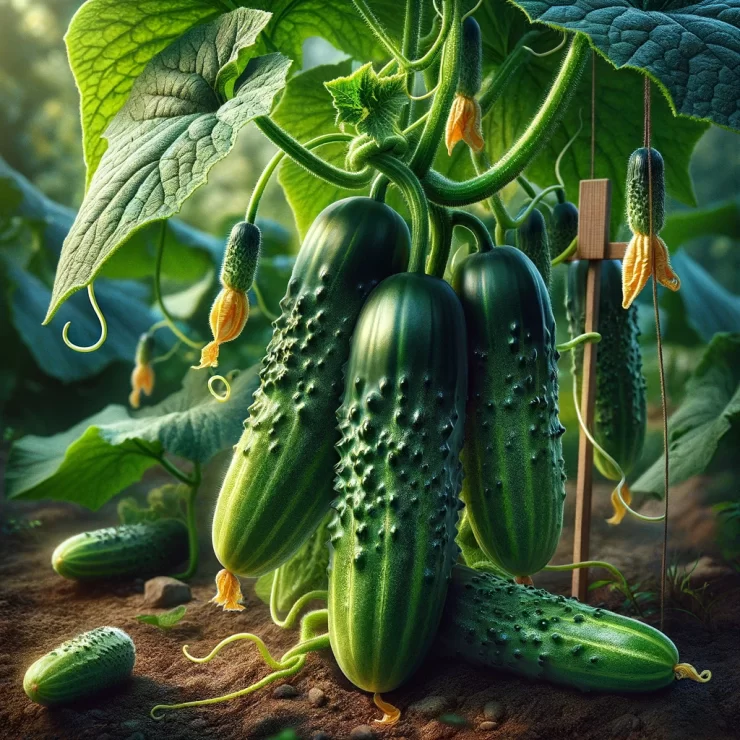Cucumbers are a staple in many gardens, beloved for their refreshing taste and versatility in culinary creations. Whether you’re a seasoned gardener or a beginner with a green thumb, successfully cultivating cucumbers requires attention to detail and avoiding common pitfalls. Here are six mistakes you should steer clear of when planting cucumbers to ensure a bountiful harvest:

- Neglecting Proper Spacing:
One of the most common mistakes made by novice gardeners is failing to provide cucumbers with adequate space to grow. Cucumber plants require ample room to spread out and thrive. When planting, ensure that you space the seeds or seedlings at least 12 to 24 inches apart in rows that are approximately 3 to 6 feet apart. Overcrowding can lead to competition for nutrients, water, and sunlight, resulting in stunted growth and decreased yields.
Skipping Soil Preparation:
Healthy soil is essential for robust cucumber plants. Before planting, take the time to prepare the soil properly. Cucumbers prefer well-drained, loamy soil with a pH level between 6.0 and 7.0. Incorporate organic matter such as compost or aged manure to improve soil structure and fertility. Additionally, consider conducting a soil test to assess nutrient levels and make any necessary amendments to ensure optimal growing conditions.
Overlooking Sunlight Requirements:
Cucumbers are sun-loving plants that thrive in full sunlight. Select a planting location that receives at least 6 to 8 hours of direct sunlight per day. Insufficient sunlight can result in poor growth and lower fruit production. Avoid planting cucumbers in shaded areas or where they may be overshadowed by taller plants.

Inadequate Watering Practices:
Proper watering is crucial for the health and productivity of cucumber plants. Keep the soil consistently moist but not waterlogged throughout the growing season, especially during hot and dry periods. Aim to water the plants at their base to prevent foliage from becoming wet, which can increase the risk of fungal diseases such as powdery mildew. Mulching around the plants can help retain soil moisture and suppress weed growth.
Failing to Provide Support:
Many cucumber varieties are vining plants that benefit from vertical support to keep the fruit off the ground and prevent disease. Install trellises, stakes, or cages at the time of planting to provide support for the vines as they grow. Training cucumbers to climb vertically not only saves space but also promotes better air circulation around the plants, reducing the risk of fungal infections and improving fruit quality.
Ignoring Pest and Disease Management:
Cucumbers are susceptible to a variety of pests and diseases, including cucumber beetles, aphids, and powdery mildew. Monitor your plants regularly for signs of damage or infestation, and take proactive measures to control pests and diseases as needed. This may include handpicking insects, applying organic pesticides or fungicides, and practicing crop rotation to reduce the buildup of pathogens in the soil.
By avoiding these common mistakes and following best practices for planting and caring for cucumbers, you can increase your chances of a successful harvest and enjoy a season filled with crisp, homegrown cucumbers for salads, pickling, and snacking. Happy gardening!
News
The WILDEST ENDINGS Of Week 12
Week 12 in professional football proved to be an unforgettable chapter filled with come-from-behind rallies, nerve-racking final possessions, and improbable last-second heroics. Fans witnessed an array of shocking comebacks that had them clutching the edges of their seats until the…
Keaton Wallace’s CAREER-HIGH 27-PT Performance In Chicago!
Keaton Wallace delivered a stunning performance in Chicago that not only showcased his growing confidence but also served as a milestone in his professional basketball journey. The rising guard dropped a career-high 27 points, captivating fans with a display of…
Damian Lillard Scores 30 Points vs Magic
Damian Lillard put on a show against the Orlando Magic, lighting up the scoreboard with a smooth 30-point performance that reminded everyone why he is regarded as one of the most lethal offensive threats in the NBA. From deep threes…
Jalen Green Was UNSTOPPABLE – 34 Points In Denver!
Jalen Green delivered a scintillating performance in Denver, putting on display the unique blend of athleticism, creativity, and confidence that has captivated fans and pundits across the league. From the opening tip, the Houston Rockets guard showcased unwavering energy, attacking…
Stephen Curry Makes It Look EASY – 31 Points In Minnesota!
Stephen Curry put on a shooting clinic in Minnesota, dazzling fans and opponents alike with his signature blend of skill, flair, and efficiency. The Golden State Warriors point guard made the game look effortless as he racked up 31 points,…
Final 3:07 CRAZY ENDING Timberwolves vs Warriors 👀
The recent clash between the Minnesota Timberwolves and the Golden State Warriors was a game that will be etched in the memories of fans for years to come, particularly for its heart-stopping final 3 minutes and 7 seconds. This wasn’t…
End of content
No more pages to load











